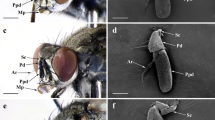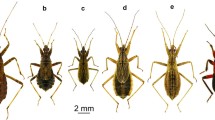Summary
Larvae of the wood-boring beetleOrthosoma brunneum respond positively to carbon dioxide (CO2) by tending to move toward the highest concentrations of CO2 while in a CO2 gradient containing less than 10% CO2 (Figs. 2,3). As is shown through experiments employing the amputation of various combinations of receptor organs, the CO2-sensitive receptors of the larvae are situated on the distal segments of the maxillary palps and the labial palps but not on the antennae (Fig. 4). The maxillary palps are of primary importance in determining the response of the larvae to CO2 gradients whereas their labial palps, though effective in mediating the response alone, play a secondary and weaker role. Since CO2 receptors on insect labial palps have not been found before, the implications of this finding are discussed.
Similar content being viewed by others
References
Bässler, U.: Versuche zur Orientierung der Stechmücken: die Schwarmbildung und die Bedeutung des Johnstonschen Organs. Z. vergl. Physiol.41, 300–330 (1958)
Boistel, J., LeComte, J., Coraboeuf, E.: Quelques aspects de l'étude électrophysiologique des récepteurs sensoriels des antennes d'Hyménoptères. Insectes Sociaux3, 25–31 (1956)
Daykin, P. N., Kellogg, F. E., Wright, R. H.: Host-finding and repulsion ofAedes aegypti. Can. Ent.97, 239–263 (1965)
Fry, F. E. J.: Effects of the environment on animal activity. Univ. of Toronto Studies, Biological Series, No 55. Toronto: University of Toronto Press 1947
Kellogg, F. E.: Water vapour and carbon dioxide receptors inAedes aegypti. J. Insect Physiol.16, 99–108 (1970)
Klingler, J.: Über den Sitz der CO2-Rezeptoren bei der Larve vonOtiorrhynchus sulcatus. Ent. exp. et appl.9, 271–277 (1966)
Lacher, V.: Elektrophysiologische Untersuchungen an einzelnen Rezeptoren für Geruch, Kohlendioxyd, Luftfeuchtigkeit und Temperatur auf den Antennen der Arbeitsbiene und der Drohne (Apis mellifica L.). Z. vergl. Physiol.48, 587–623 (1964)
Paim, U., Beckel, W. E.: Seasonal oxygen and carbon dioxide content of decaying wood as a component of the microenvironment ofOrthosoma brunneum (Forster) (Coleoptera: Cerambycidae). Canad. J. Zool.41, 1133–1147 (1963)
Paim, U., Beckel, W. E.: The behavior of the larvae ofOrthosoma brunneum (Forster) (Coleoptera, Cerambycidae) in relation to gases found in the logs inhabited by the larvae. Canad. J. Zool.42, 327–353 (1964)
Roessler, H. P.: Versuche zur geruchlichen Anlockung weiblicher Stechmücken (Aëdes aegypti L., Culicidae). Z. vergl. Physiol.44, 184–231 (1961)
Willis, E. R., Roth, L. M.: Reactions ofAedes aegypti (L.) to carbon dioxide. J. exp. Zool.121, 149–179 (1952)
Willis, E. R., Roth, L. M.: Reactions of flour beetles of the genusTribolium to carbon dioxide and dry air. J. exp. Zool.127, 117–152 (1954)
Author information
Authors and Affiliations
Additional information
This study was supported by grants to U.P. and W.D.S. from the National Research Council of Canada. Thanks are due to the personnel of the Ministry of Natural Resources of Ontario for permission to collect larvae and adults ofO. brunneum in Rondeau Provincial Park.
Rights and permissions
About this article
Cite this article
White, R.A., Paim, U. & Seabrook, W.D. Maxillary and labial sites of carbon dioxide-sensitive receptors of larvalOrthosoma brunneum (Forster) (Coleoptera, Cerambycidae). J. Comp. Physiol. 88, 235–246 (1974). https://doi.org/10.1007/BF00697957
Received:
Issue Date:
DOI: https://doi.org/10.1007/BF00697957




